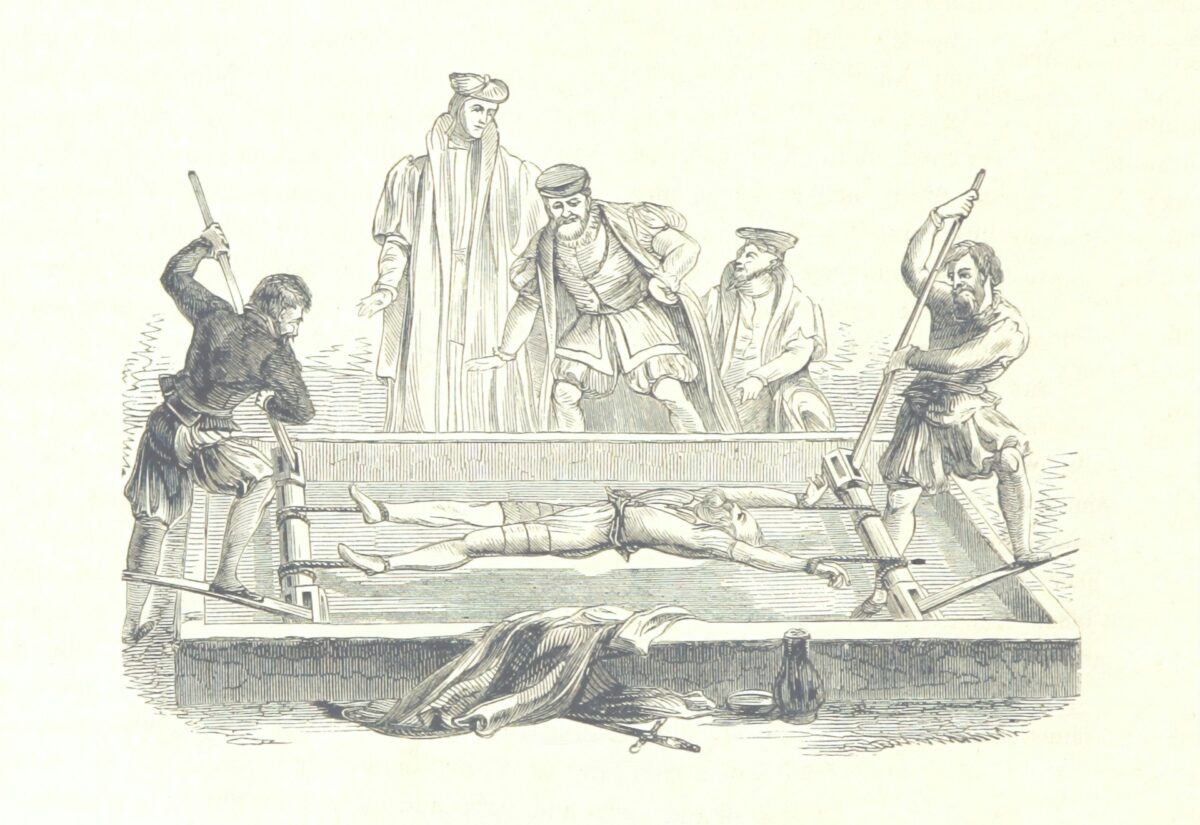12 Bizarre Medieval Punishments Used In British Courts
- Gail Stewart
- May 11, 2025
 Unsplash/British Library
Unsplash/British LibraryMedieval Britain had a harsh and often theatrical approach to justice. Long before prisons became the standard punishment, the legal system favoured physical pain, public humiliation, and symbolic retribution. These punishments weren’t just about upholding the law—they were about putting on a show. Justice was often performed publicly, with an emphasis on shame and spectacle. Many of the methods used were designed to deter others by making an unforgettable example of the accused. To modern eyes, they can seem barbaric, ridiculous, or downright grotesque, but in their time, they were accepted—and in some cases, even celebrated—as a necessary part of maintaining order. Here are some of the most unusual, unsettling, and occasionally surreal punishments handed out by British courts during the Middle Ages.
1. Trial by ordeal
Before evidence-based trials or consistent legal procedures, determining guilt often relied on what was believed to be divine judgment. Trial by ordeal was one of the most common methods, where God was expected to reveal the truth through the outcome of a physically dangerous task.
One widespread example was the ordeal by hot iron. The accused would carry a red-hot iron bar for a set distance or hold it in their hand. The wound would then be bandaged and examined after three days. If it had healed cleanly, the person was considered innocent; if it was infected, they were guilty. There was also the ordeal by water, where the accused was bound and thrown into a body of water. Floating meant guilt, as the water was believed to reject the guilty, while sinking suggested innocence—but could just as easily result in drowning. Despite the risk, many people submitted to these tests, believing divine intervention would prove their innocence.
2. The pillory
The pillory was a wooden frame, often set up in a busy town square, with holes for the offender’s head and hands. It wasn’t just a method of restraint—it was an invitation for public scorn. Passersby would throw rotten food, stones, mud, or anything else they had to hand. Verbal abuse was common, and physical attacks weren’t unusual.
This punishment was typically used for crimes such as perjury, fraud, dishonest trading, or drunkenness. While it didn’t involve physical pain from the state itself, the public were encouraged to take part in the humiliation. It could last for hours or even days, depending on the offence. People left the pillory with injuries, and sometimes the crowd’s enthusiasm turned deadly. It was punishment by mob, endorsed by the court.
3. The ducking stool
The ducking stool was a device attached to a long wooden beam or see-saw mechanism, with a chair strapped to one end. The accused—typically women accused of being “scolds,” gossips, or witches—would be tied into the chair and repeatedly plunged into a river or pond.
This punishment combined humiliation with the very real risk of drowning, especially during colder months. The aim wasn’t just to punish, but to correct behaviour considered socially disruptive. While some duckings were relatively symbolic, others resulted in hypothermia or injury. The practice reveals much about gender expectations in the medieval period and how justice was often used to enforce them.
4. Hanging, drawing, and quartering
Perhaps the most infamous of all medieval punishments, hanging, drawing, and quartering was reserved for men found guilty of high treason. It was a theatrical, excruciatingly drawn-out execution process designed to reinforce the power of the monarchy.
The condemned would first be dragged to the place of execution on a hurdle. They would then be hanged by the neck—but cut down before death. This was followed by disembowelment and castration, often while still conscious. The organs were burned in front of the victim before they were beheaded, and the body cut into four parts. These quarters were then sent to different parts of the kingdom to be displayed publicly. Crowds were encouraged to witness the execution, and attendance was often treated as a civic duty.
5. Branding
Branding was used to mark criminals permanently, literally burning their crime into their flesh. Hot irons would be shaped into letters corresponding to the offence—”T” for thief, “F” for forger, and so on—and pressed against the hand, cheek, or forehead.
This mark was not just punitive—it was meant to follow someone for life, making reintegration into society near impossible. It affected their employment, marriage prospects, and personal safety. Branding combined punishment with a lasting public warning, and it was often used alongside other penalties.
6. The scold’s bridle
The scold’s bridle, also known as a brank, was a metal contraption that encased a person’s head, with a plate or spike inserted into the mouth to prevent speech. It was almost exclusively used on women considered “mouthy,” nagging, or quarrelsome.
In addition to suppressing speech, the device caused physical pain and humiliation. Those forced to wear it were often paraded through the streets, accompanied by jeers and insults. The bridle was not just a punishment—it was a way of reinforcing social norms about female behaviour and punishing those who defied them.
7. Amputation for theft
In some cases, those convicted of stealing—especially repeat offenders or those who stole valuable goods—were sentenced to have a hand, ear, or even foot cut off. This brutal punishment was meant to both penalise and deter.
The symbolism was clear: take the hand that committed the crime. It also served a practical purpose, making future thefts more difficult. Amputation was public and irreversible. However, those with wealth or status often avoided it by paying a fine or offering compensation. Justice, as in many periods, wasn’t always evenly applied.
8. Death by pressing (peine forte et dure)
If an accused person refused to enter a plea—either to delay the trial, protest the system, or protect their family’s assets—they could be subjected to “peine forte et dure,” or death by pressing. The accused would be stripped, laid on the ground, and gradually crushed under increasingly heavy stones.
The process was slow and excruciating. Sometimes, the accused would finally enter a plea to end the torture. Other times, they stayed silent to the end. The most well-known case in England was that of Margaret Clitherow in 1586, who was pressed to death for refusing to plead to charges of harbouring Catholic priests.
9. Whipping
Flogging was one of the most common forms of corporal punishment. It was handed out for a wide range of offences, from petty theft and public drunkenness to breaking curfews or engaging in lewd behaviour. Offenders were tied to a whipping post in a public area and lashed with a whip or rod.
The number of lashes varied depending on the crime, and injuries could be severe—sometimes even fatal, especially when infection set in. The aim was to shame and physically harm in equal measure, reinforcing the consequences of even minor crimes. The presence of a watching crowd made the experience all the more degrading.
10. Tarring and feathering
Though it became more associated with mob justice in later centuries, tarring and feathering has medieval roots. It involved pouring hot tar over the accused’s body and then covering them in feathers, either to mock or punish. The result was both physically painful and utterly humiliating.
This form of punishment was sometimes applied to corrupt officials or swindlers and was often a community-led act of public vengeance. The burns from the tar could be severe, and the victim was usually paraded through town as a warning. While not officially sanctioned in many court systems, it was tolerated or even encouraged in certain cases.
11. The drunkard’s cloak
A lesser-known punishment, the drunkard’s cloak was a barrel or cask with holes cut for the arms and head. Habitual drunkards were made to wear it in public as a form of shame. It restricted movement and made the wearer look absurd, drawing laughter and ridicule from onlookers.
It was used in some parts of Britain and Europe as a local punishment, and while not physically harmful, it was intended to humiliate and discourage repeat offences. It’s a clear example of punishment as performance.
12. The jougs
Common in Scotland, the jougs were a metal collar attached to a chain fixed to a wall or post, usually outside a church. Offenders were locked into the collar, often on a Sunday when church attendance was high.
The aim was to expose the person to the community, letting them be stared at, mocked, or preached at. It was used for offences like gossiping, missing church, or minor moral failings. The punishment could last hours, depending on the severity of the crime.
These punishments weren’t just about enforcing justice—they were about fear, shame, power, and spectacle. In an era before professional police forces and structured prison systems, the goal was to make crime visible, memorable, and terrifying. Punishment was meant to be watched, felt, and remembered. These brutal practices offer a grim glimpse into a society that valued conformity and deterrence over rehabilitation. And while the methods have changed, the underlying questions about how we punish—and why—still echo in modern justice systems today.



